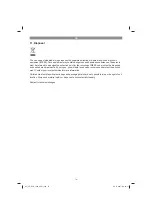
GB
- 69 -
circumstances.
f) Wear suitable work clothes. Do not wear
loose clothing or jewellery. Keep hair, clo-
thes and gloves away from moving parts.
Loose clothing, jewellery or long hair can get
trapped in moving parts.
g) If vacuuming devices and draining de-
vices can be
fi
tted, make sure that these
are correctly attached and correctly used.
The use of a dust extraction system can redu-
ce the danger posed by dust.
4. Usage and treatment of the electric tool
a) Do not overload the appliance. Use the
correct tool for your work.
You will be able
to work better and more safely within the gi-
ven performance boundaries.
b) Do not use an electric tool with a defec-
tive switch.
An electric tool that cannot be
switched on or o
ff
is dangerous and must be
repaired.
c) Pull the plug out of the socket and/or
remove the battery before making any ad-
justments to the appliance, changing ac-
cessories or put the appliance down.
This
safety measure prevents starting the electric
tool unintentionally.
d) Keep unused electric tools out of the
reach of children. Do not allow people
who are not familiar with the appliance or
who have not read these instructions to
use the appliance.
Electric tools are dange-
rous if they are used by inexperienced people.
e) Clean your electric tool carefully. Check
whether moving parts are functioning
properly and not jamming, whether parts
are broken or damaged enough that the
functioning of this electric tool is a
ff
ec-
ted. Have damaged parts repaired before
using the appliance.
Many accidents are
caused by badly maintained electric tools.
f) Keep your cutting tools sharp and clean.
Carefully maintained cutting tools with sharp
cutting edges will jam less and are easier to
control.
g) Make sure to use electric tools, accesso-
ries, attachments, etc. in accordance with
these instructions. Take the conditions in
your work area and the job in hand into
account.
Using electric tools for any purpose
other than the one for which they are intended
can lead to dangerous situations.
5. Service
a) Have your electric tool repaired only by
trained personnel using only genuine
spare parts
. This will ensure that your elec-
tric tool remains safe to use.
Additional safety instructions
a) Use the equipment only with brushes which
are in
fl
awless condition. The must be no
signs of rust or damage on the brushes.
b) Only use the equipment with brushes sup-
plied or recommended by the manufacturer
and with a permissible maximum speed
matching at least the speci
fi
ed speed of the
equipment.
c) Never use the brushes on other equipment.
d) Brushes must not be mounted on machines
whose speed is above the maximum permit-
ted brush speed.
e) Damaged brushes must not be used.
f) Rust discoloration or other signs of chemical
or mechanical changes to the trimming ma-
terial can lead to the premature failure of the
brush.
g) Brushes must be stored in suitable frames,
containers or boxes in such a way that they
are protected from the following in
fl
uences:
1) high humidity, heat, water or other liquids
that could cause damage to the brush.
2) acids or fumes of acids that could cause
damage
3) temperatures that are so low that they
could cause condensation on the brushes if
they are moved to an area with higher tem-
peratures
4) deformation of any brush component
This equipment can be used by
children of 8 years and older and
by people with limited physical,
sensory or mental capacities or
those with no experience and
knowledge if they are supervised
or have received instruction in
how to use the equipment safe-
ly and understand the dangers
which result from such use.
Children are not allowed to play
with the equipment. Unless su-
Anl_PE_EFR_1410_SPK7.indb 69
Anl_PE_EFR_1410_SPK7.indb 69
24.11.2017 06:43:17
24.11.2017 06:43:17





























